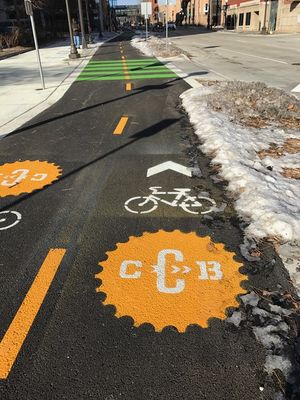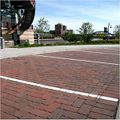
Difference between revisions of "Category:Level 3 - General information, reference, tables, images, and archives/Images/Permeable pavement photos"
(Created page with "thumb|300px|alt=photo illustrating an example of pervious concrete|<font size=3>An example of pervious concrete.</font size> File:P...") |
m |
||
| Line 4: | Line 4: | ||
Permeable pavements allow stormwater runoff to filter through surface voids into an underlying stone reservoir for temporary storage and/or infiltration. The most commonly used permeable pavement surfaces are pervious concrete, porous asphalt, and permeable interlocking concrete pavers (PICP). Permeable pavements have been used for areas with light traffic at commercial and residential sites to replace traditional impervious surfaces in low-speed roads, alleys, parking lots, driveways, sidewalks, plazas, and patios. While permeable pavements can withstand truck loads, permeable pavement has not been proven in areas exposed to high repetitions of trucks or in high speed areas because its’ structural performance and surface stability have not yet been consistently demonstrated in such applications. | Permeable pavements allow stormwater runoff to filter through surface voids into an underlying stone reservoir for temporary storage and/or infiltration. The most commonly used permeable pavement surfaces are pervious concrete, porous asphalt, and permeable interlocking concrete pavers (PICP). Permeable pavements have been used for areas with light traffic at commercial and residential sites to replace traditional impervious surfaces in low-speed roads, alleys, parking lots, driveways, sidewalks, plazas, and patios. While permeable pavements can withstand truck loads, permeable pavement has not been proven in areas exposed to high repetitions of trucks or in high speed areas because its’ structural performance and surface stability have not yet been consistently demonstrated in such applications. | ||
| − | This page provides links to photos for permeable pavement. | + | This page (Category) provides links to photos for permeable pavement. |
[[Category:Level 3 - Best management practices/Structural practices/Permeable pavement]] | [[Category:Level 3 - Best management practices/Structural practices/Permeable pavement]] | ||
[[Category:Level 2 - General information, reference, tables, images, and archives/Images]] | [[Category:Level 2 - General information, reference, tables, images, and archives/Images]] | ||
Revision as of 19:04, 11 August 2022
Permeable pavements allow stormwater runoff to filter through surface voids into an underlying stone reservoir for temporary storage and/or infiltration. The most commonly used permeable pavement surfaces are pervious concrete, porous asphalt, and permeable interlocking concrete pavers (PICP). Permeable pavements have been used for areas with light traffic at commercial and residential sites to replace traditional impervious surfaces in low-speed roads, alleys, parking lots, driveways, sidewalks, plazas, and patios. While permeable pavements can withstand truck loads, permeable pavement has not been proven in areas exposed to high repetitions of trucks or in high speed areas because its’ structural performance and surface stability have not yet been consistently demonstrated in such applications.
This page (Category) provides links to photos for permeable pavement.
Media in category "Level 3 - General information, reference, tables, images, and archives/Images/Permeable pavement photos"
The following 12 files are in this category, out of 12 total.
- Bike lane st paul.JPG 480 × 640; 94 KB
- Bioretention and ppavement.jpg 1,313 × 1,970; 999 KB
- Central corridor permeable pavment.jpg 1,500 × 1,125; 289 KB
- K2id-1100-permeablepaver.jpg 840 × 506; 73 KB
- Pave Drain Installation.png 947 × 630; 1.01 MB
- Perm asphalt bikeway.JPG 480 × 640; 173 KB
- Permeable pavement maintenance.png 658 × 510; 761 KB
- Permeable pavement photo 1.jpg 724 × 543; 73 KB
- Picture of permeable interlocking concrete pavement 1.jpg 600 × 599; 104 KB
- Picture of porous asphalt 1.jpg 624 × 600; 80 KB
- Picture of porous concrete 1.jpg 686 × 599; 106 KB
- Univ of MN PICP Photograph.jpg 1,899 × 1,605; 673 KB













